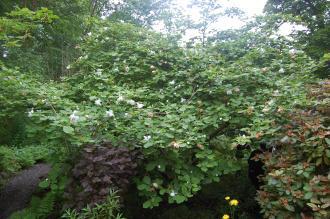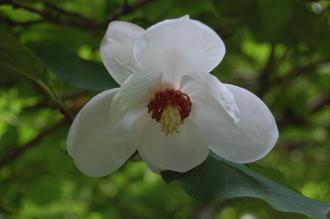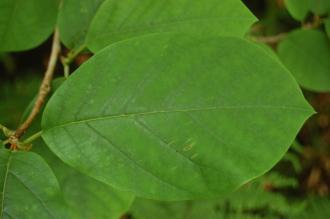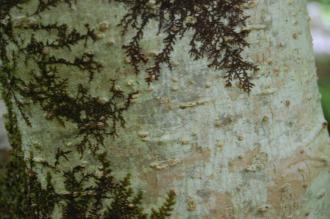
Magnolia wilsonii (16/06/2014, Dunvegan Castle, Isle of Skye, Scotland)
Position: Full sun to dappled shade
Flowering period: Late spring to early summer
Soil: Moist, well drained
Eventual Height: 8m
Eventual Spread: 8m
Hardiness: 7b, 8a, 8b, 9a, 9b
Family: Magnoliaceae

Magnolia wilsonii Flower (16/06/2014, Dunvegan Castle, Isle of Skye, Scotland)
Magnolia wilsonii is a deciduous, large shrub or small tree with a spreading, rounded habit. Its mid green leaves are narrowly ovate with entire margins, up to 16cm long and 7cm broad. These emerge bronze/ green and become yellow in autumn before they fall. Its silvery gray bark is smooth. Its fragrant white flowers have deep red centres, are cup shaped, up to 10cm across and emerge from red/ purple shoots. Its red fruit are up to 10cm long 5cm long.
Magnolia wilsonii, commonly known as the Wilson’s Magnolia, is native to south east China. In its native habitat it grows as an understory shrub. Magnolia wilsonii is considered to be Endangered according to the IUCN Red List of Threatened Species.

Magnolia wilsonii Leaf (16/06/2014, Dunvegan Castle, Isle of Skye, Scotland)
The etymological root of the binomial name Magnolia was named after Pierre Magnol, a 17th century French botanist. Wilsonii is named after Ernest Wilson (1876 – 1930), an English plant collector.
The landscape architect may find Magnolia wilsonii useful as a large, flowering specimen shrub. It prefers a sheltered position.
Ecologically, Magnolia wilsonii flowers are attractive to nectar loving insects. Its seeds are attractive to some birds.
The Royal Horticultural Society has given Magnolia wilsonii their prestigious Award of Garden Merit in 1993.

Magnolia wilsonii Bark (16/06/2014, Dunvegan Castle, Isle of Skye, Scotland)
Magnolia wilsonii prefers moist, fertile, humus rich, well-drained soils. It tolerates most pH of soil, although it prefers acidic soils.
Magnolia wilsonii requires little maintenance. If required, pruning should be carried out after flowering. Care should be taken not to damage the roots of this plant.

